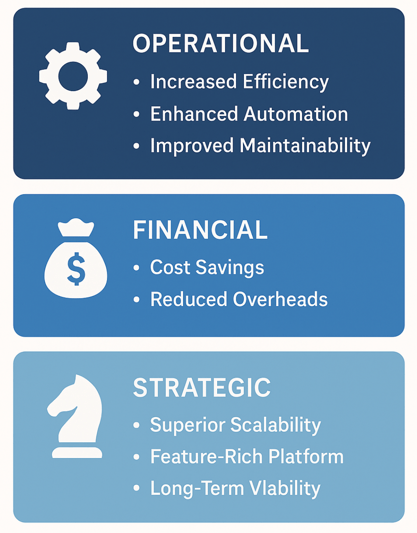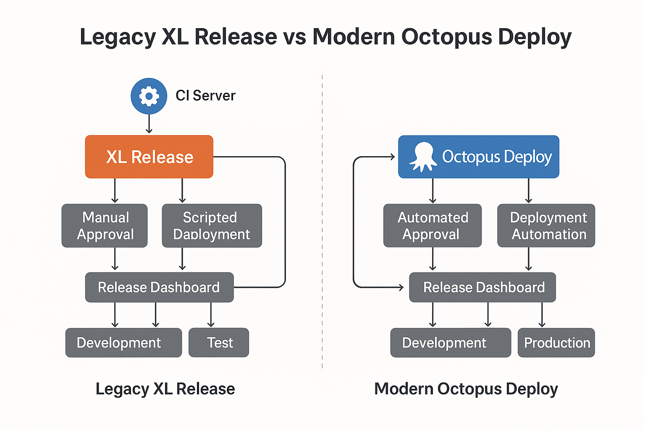Migrating from XL Release to Octopus Deploy–Technical & Business Guide
Deployment automation has become the invisible backbone of business agility. Yet many organisations still rely on legacy release orchestration tools like XL Release—once a pioneer, now an increasingly rigid framework in a world that demands flexibility, scalability, and automation-first thinking.
If your goal is to accelerate software delivery, modernise your toolchain, and cut operational costs without compromising control, migrating to Octopus Deploy might be one of the most impactful engineering decisions you make this year.
Why organisations are moving on from XL Release
Originally built by XebiaLabs and now part of Digital.ai, XL Release was designed to orchestrate complex release processes across teams. It offered dashboards, manual approvals, and coordination across applications. For its time, it was revolutionary.
But as DevOps evolved into continuous delivery, the focus shifted from orchestration to end-to-end automation. Cloud-native architectures, containerisation, and hybrid environments require more than just tracking tasks—they need intelligent deployment engines capable of rolling updates, blue-green deployments, and infrastructure automation at scale.
XL Release’s architecture has not kept pace with these modern needs. Its reliance on manual intervention, limited cloud-native integrations, and opaque licensing structures make it increasingly costly to maintain.
By contrast, Octopus Deploy has grown into a versatile, enterprise-grade platform that automates deployments, simplifies governance, and scales effortlessly across environments and tenants—all while remaining transparent and developer-friendly.
Technical comparison: XL Release vs Octopus Deploy
|
Aspect |
XL Release |
Octopus Deploy |
|
Core focus |
Release orchestration and tracking |
Deployment automation and orchestration |
|
Deployment patterns |
Sequential, templated flows with manual tasks |
Rolling, canary, blue-green, and multi-tenant deployments |
|
Integration ecosystem |
ServiceNow, JIRA, Jenkins (via plugins) |
GitHub, GitLab, Azure DevOps, AWS, Docker, Slack, Kubernetes |
|
Scalability |
Designed for coordination, not massive deployment scale |
Built for multi-tenant, multi-environment scale |
|
Governance |
Manual approvals and audit trails |
Full RBAC, audit logging, environment segregation, approvals |
|
Maintenance |
On-prem installation and plugin upkeep |
SaaS (Octopus Cloud) or on-prem—vendor handles maintenance for Cloud |
|
Pricing model |
Enterprise licensing, opaque pricing |
Transparent, usage-based pricing starting around £300/year |
|
DevSecOps readiness |
Basic integrations and scripting |
Native support for modern pipelines and infrastructure-as-code |
|
Ease of use |
Strong UI for release managers |
Strong UI for both engineers and managers; easier templating |
In short, XL Release coordinates—Octopus Deploy automates. The latter is purpose-built for today’s DevOps, DevSecOps, and Platform Engineering practices.
Technical advantages of Octopus Deploy
One process, many environments
Define your deployment steps once and promote across development, testing, staging, and production. Octopus’s variable scoping and spaces enable clean separation of environments without duplication.
Multi-tenant and microservices-ready
If you serve multiple customers or microservices, Octopus’s multi-tenant model allows a single deployment pipeline to target thousands of configurations safely and consistently.
Runbooks for operational automation
Beyond deployment, Octopus Runbooks automate repetitive operational tasks—such as database migrations, cache purges, and infrastructure provisioning—bridging Dev and Ops seamlessly.
Rich integrations
Octopus integrates natively with modern CI systems (GitHub Actions, Jenkins, Azure DevOps), cloud providers (AWS, Azure, GCP), and container environments (Docker, Kubernetes). This ensures your toolchain evolves alongside your business.
Security and compliance
Every deployment is versioned, auditable, and permission-controlled. C-level stakeholders can see who deployed what, when, and where—crucial for regulated industries like finance, healthcare, and the public sector.
Business advantages: Speed, cost, and reliability
Transparent, predictable cost
While XL Release licensing often involves custom negotiation, Octopus pricing is publicly available and usage-based. Typical enterprise annual spend is around 2 times higher for legacy orchestration suites than for Octopus.
Reduced downtime and risk
Fewer manual steps mean fewer failed deployments. Real-world Octopus users report reducing average downtime from one hour to under ten minutes. Blue-green and canary patterns minimise disruption even during rollouts.
Faster time-to-market
Automated deployments shorten release cycles dramatically. Teams can deploy multiple times a day, turning business ideas into customer-facing features in hours instead of weeks.
Maintenance advantage
If you opt for Octopus Cloud, patching, scaling, and backups are handled by the vendor—freeing engineers from tool maintenance and allowing them to focus on value creation.
Lower total cost of ownership
Consider this simplified example:
- 100 releases per year, each requiring 4 manual hours on XL Release
- 400 engineering hours at £50/hour = £20,000
- With Octopus automation (1 hour each), that cost drops to £5,000
- Add lower licensing (~£15k vs £30k) and downtime reduction, and the annual saving can exceed £35,000
Strategic advantages for management and C-level
- Greater visibility: Unified dashboards show deployment status across teams and environments.
- Compliance and governance: Full audit trails satisfy regulatory and internal audit requirements.
- Team empowerment: Developers gain self-service deployment capabilities with role-based guardrails.
- Risk reduction: Controlled rollbacks and progressive delivery reduce production incidents.
- Future-proofing: Built for containers, multi-cloud, and hybrid environments—no need to rebuild pipelines later.
This is not just a technical upgrade; it’s a strategic investment in business agility and operational resilience.

Migration roadmap: From XL Release to Octopus Deploy
Phase 1: Discovery and assessment
- Inventory current pipelines, environments, scripts, and dependencies in XL Release.
- Identify inefficiencies—manual gates, redundant templates, unreliable scripts.
- Define target outcomes: automation, auditability, speed, cost reduction.
- Map XL Release features to Octopus equivalents.
Phase 2: Pilot migration
- Select a non-critical service for proof-of-concept.
- Configure Octopus (Cloud or Server), create a project and deployment process.
- Integrate with existing CI pipelines.
- Validate KPIs—deployment time, failure rate, manual steps removed.
Phase 3: Rollout and scaling
- Build standardised templates and reusable step libraries.
- Migrate high-impact pipelines first, with gradual adoption across teams.
- Introduce multi-tenant and runbook automation.
- Train teams, establish governance and approval models.
Phase 4: Optimisation and governance
- Introduce advanced deployment patterns (blue-green, canary).
- Automate operational runbooks for infra maintenance.
- Retire XL Release infrastructure to reduce maintenance overhead.
- Track KPIs—deployment frequency, failure rate, cost savings, time-to-market.
This phased approach ensures controlled change, measurable success, and minimal risk.

Risk management and mitigations
Our migration framework includes a phased delivery model, automated validation, and controlled rollouts, ensuring that each stage is measurable and reversible. We begin with a comprehensive fit-gap and dependency analysis to uncover hidden complexities before they cause friction. Our approach blends engineering with business assurance, ensuring a smooth, secure, and low-risk transition from XL Release to Octopus Deploy.
|
Risk |
Mitigation |
|
Complex migration |
Start with pilot, automate configuration mapping |
|
Feature gaps |
Redesign old processes to align with modern best practices |
|
Cost misestimation |
Model tenant and machine counts early |
|
Team resistance |
Provide training, celebrate pilot success |
A tool for the next decade of DevOps
Octopus Deploy is not merely a deployment engine—it’s an enabler of platform maturity. By aligning automation, governance, and scalability, it helps organisations deliver faster, safer, and more economically.
For DevOps engineers, it’s a robust and elegant solution.
For product managers, it’s visibility and predictability.
For executives, it’s a measurable return on investment.
Migrating from XL Release to Octopus Deploy is less about leaving a tool behind and more about embracing the next generation of release automation—where every deployment is reliable, auditable, and lightning fast.
How we help
Bion helps organisations modernise their DevOps pipelines and accelerate delivery with Octopus Deploy and cloud-native automation.
Get in touch to discuss your migration roadmap or to run a no-cost readiness assessment of your current release automation setup.
